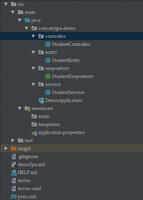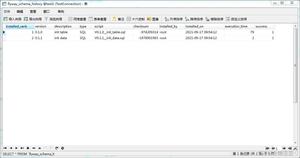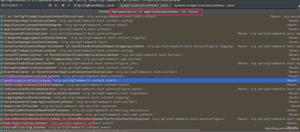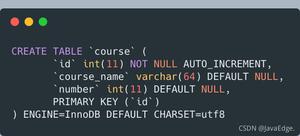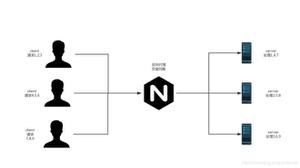如何在Spring中使用2个或更多数据库?
我有一个运行Spring MVC的应用程序。
我需要它来访问我的应用程序中的2个不同的数据库(一个是PostgreSQL,另一个是MySQL数据库)。
如何仅使用批注或application.properties文件进行配置?
回答:
这是示例代码,希望multiple Database/datasource对你有所Spring-Boot帮助!
application.properties
spring.ds_items.driverClassName=org.postgresql.Driver spring.ds_items.url=jdbc:postgresql://srv0/test
spring.ds_items.username=test0
spring.ds_items.password=test0
spring.ds_users.driverClassName=org.postgresql.Driver
spring.ds_users.url=jdbc:postgresql://srv1/test
spring.ds_users.username=test1
spring.ds_users.password=test1
DatabaseItemsConfig.java
package sb; import org.springframework.boot.autoconfigure.jdbc.TomcatDataSourceConfiguration;
import org.springframework.boot.context.properties.ConfigurationProperties;
import org.springframework.context.annotation.Bean;
import org.springframework.context.annotation.Configuration;
import org.springframework.jdbc.core.JdbcTemplate;
import javax.sql.DataSource;
@Configuration
@ConfigurationProperties(name = "spring.ds_items")
public class DatabaseItemsConfig extends TomcatDataSourceConfiguration {
@Bean(name = "dsItems")
public DataSource dataSource() {
return super.dataSource();
}
@Bean(name = "jdbcItems")
public JdbcTemplate jdbcTemplate(DataSource dsItems) {
return new JdbcTemplate(dsItems);
}
}
DatabaseUsersConfig.java
package sb; import org.springframework.boot.autoconfigure.jdbc.TomcatDataSourceConfiguration;
import org.springframework.boot.context.properties.ConfigurationProperties;
import org.springframework.context.annotation.Bean;
import org.springframework.context.annotation.Configuration;
import org.springframework.jdbc.core.JdbcTemplate;
import javax.sql.DataSource;
@Configuration
@ConfigurationProperties(name = "spring.ds_users")
public class DatabaseUsersConfig extends TomcatDataSourceConfiguration {
@Bean(name = "dsUsers")
public DataSource dataSource() {
return super.dataSource();
}
@Bean(name = "jdbcUsers")
public JdbcTemplate jdbcTemplate(DataSource dsUsers) {
return new JdbcTemplate(dsUsers);
}
}
ItemRepository.java
package sb; import org.slf4j.Logger;
import org.slf4j.LoggerFactory;
import org.springframework.beans.factory.annotation.Autowired;
import org.springframework.beans.factory.annotation.Qualifier;
import org.springframework.jdbc.core.JdbcTemplate;
import org.springframework.jdbc.core.RowMapper;
import org.springframework.stereotype.Repository;
import java.sql.ResultSet;
import java.sql.SQLException;
@Repository
public class ItemRepository {
protected final Logger log = LoggerFactory.getLogger(getClass());
@Autowired
@Qualifier("jdbcItems")
protected JdbcTemplate jdbc;
public Item getItem(long id) {
return jdbc.queryForObject("SELECT * FROM sb_item WHERE id=?", itemMapper, id);
}
private static final RowMapper<Item> itemMapper = new RowMapper<Item>() {
public Item mapRow(ResultSet rs, int rowNum) throws SQLException {
Item item = new Item(rs.getLong("id"), rs.getString("title"));
item.price = rs.getDouble("id");
return item;
}
};
}
UserRepository.java
package sb; import org.slf4j.Logger;
import org.slf4j.LoggerFactory;
import org.springframework.beans.factory.annotation.Autowired;
import org.springframework.beans.factory.annotation.Qualifier;
import org.springframework.jdbc.core.JdbcTemplate;
import org.springframework.jdbc.core.RowMapper;
import org.springframework.stereotype.Repository;
import java.sql.ResultSet;
import java.sql.SQLException;
@Repository
public class UserRepository {
protected final Logger log = LoggerFactory.getLogger(getClass());
@Autowired
@Qualifier("jdbcUsers")
protected JdbcTemplate jdbc;
public User getUser(long id) {
return jdbc.queryForObject("SELECT * FROM sb_user WHERE id=?", userMapper, id);
}
private static final RowMapper<User> userMapper = new RowMapper<User>() {
public User mapRow(ResultSet rs, int rowNum) throws SQLException {
User user = new User(rs.getLong("id"), rs.getString("name"));
user.alias = rs.getString("alias");
return user;
}
};
}
Controller.java
package sb; import org.slf4j.Logger;
import org.slf4j.LoggerFactory;
import org.springframework.beans.factory.annotation.Autowired;
import org.springframework.web.bind.annotation.RequestMapping;
import org.springframework.web.bind.annotation.RequestParam;
import org.springframework.web.bind.annotation.RestController;
@RestController
public class Controller {
protected final Logger log = LoggerFactory.getLogger(getClass());
@Autowired
private UserRepository users;
@Autowired
private ItemRepository items;
@RequestMapping("test")
public String test() {
log.info("Test");
return "OK";
}
@RequestMapping("user")
public User getUser(@RequestParam("id") long id) {
log.info("Get user");
return users.getUser(id);
}
@RequestMapping("item")
public Item getItem(@RequestParam("id") long id) {
log.info("Get item");
return items.getItem(id);
}
}
应用程序
package sb; import org.springframework.boot.SpringApplication;
import org.springframework.boot.autoconfigure.EnableAutoConfiguration;
import org.springframework.boot.autoconfigure.jdbc.DataSourceAutoConfiguration;
import org.springframework.context.annotation.ComponentScan;
import org.springframework.context.annotation.Configuration;
@EnableAutoConfiguration(exclude = DataSourceAutoConfiguration.class)
@Configuration
@ComponentScan(basePackages = "sb")
public class Application {
public static void main(String[] args) throws Throwable {
SpringApplication app = new SpringApplication(Application.class);
app.run();
}
}
以上是 如何在Spring中使用2个或更多数据库? 的全部内容, 来源链接: utcz.com/qa/419434.html

